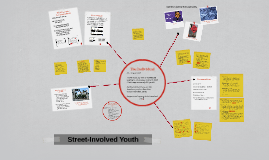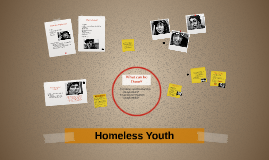Homeless Youth
Transcript: D) Family Counseling Nearly 50% of young people who participated in family mediation wound up remaining at home, or if they were homeless, returned home,” (Quilgars et al., 2008) E) Working in Schools Inform young people about homelessness, to help them to identify and address situations where they may be at risk of homelessness and to provide them with information about services and supports for crisis situations (McLean 2005). F) Respite/Emergency Accomodations and Timely Intervention Temporary emergency accommodation gives young people a break from their family or temporary shelter while they are looking for somewhere else to stay. Research suggests that if there is no intervention for youth within the first two weeks on the street they are more likely to become entrenched in street culture withing two months. (McLean 2005). Kidd, S.A. (2007), Youth homelessness and social stigma. Journal of Youth and Adolescence, 36, 291-299 Martijn, C. and Sharpe, L. (2006). Pathways to youth homelessness. Social Science & Medicine, 62, 1-12. Morton, E. (2014), Social planing and research council, Street youth planning collaborative. Social Work 4o03: Social work with communities. Feb 19 2014 Phelan, J., Link, B. G., & Moore, R. E. (1997). The stigma of homelessness: the impact of the label “homeless” on attitudes toward poor persons. Social Psychology Quarterly, 60323-337. Raleigh-DuRoff, C. (2004). Factors that Influence Homeless Adolescents to Leave or Stay Living on the Street. Child and Adolescent Social Work Journal, 21 (6), 561-572. Wingard, J., & Vengris, J. (2007). The addressing the needs of street-involved and homeless youth in hamilton project: Progress report--the first year and a half. Informally published manuscript, Social Planning and Research Council , Retrieved from http://www.sprc.hamilton.on.ca/wp-content/uploads/2007/11/The-Addressing-the-Needs-of-Street-Involved-and-Homeless-Youth-in-Hamilton-Project-Progress-Report-November-2007.pdf Pathways to Street Involvement What Does This Community Need? What Does Street Involvement Look Like? Stigma Experiences of Stigma--Youth who reported experiences of stigma had lower self-esteem, increased suicidal ideation, increased feelings of loneliness (Kidd, 2007). Reluctance to Access Services--There are several reasons for not accessing services including: -gaps between youth and adult services -Gender specific services that may not meet the needs of some LGBTQ+ youth (Gharabaghi & Stuart, 2010) Maladaptive Coping--Increased time spent on the street can lead to increased risks of substance use, criminal involvement, and mental health issues. (Fielding & Forchuk, 2013) A) Increased Funding Services for street-involved youth are typically underfunded with overworked staff and few resources B) A Shift in Public Perception The lens through which homeless youth are often seen by social services creates ambivalence in youth with regards to seeking services (Hyde, 2005). The youth in the homeless community are often seen by service providers as being powerless or victimized, whereas the youth’s perception of their decision to leave home is that of gaining autonomy (Hyde, 2005) Community Challenges The Individual Common stigmatic attributions towards the homeless youth community include: -Criminal activity -Delinquency and other behavioral concerns -Lazy nature -Legal issues -Mental Illness -Poor attitudes -School refusal -Sexual Deviancy -Sex trade work -Substance abuse Who is Helping? Bender, K., Thompson, S. J., McManus, H., Lantry, J., & Flynn, P. M. (2007). Capacity for survival: Exploring strengths of homeless street youth. Child Youth Care Forum, 36, 25-42 Calgary Homeless Foundation. (2011). Plan to End Youth Homelessness in Calgary. Calgary, AB: O’Neil Towers. Canadian Housing and Renewal Association. (2012). Ending Youth Homeless: A CHRA Policy Position Statement. Ottawa, ON: CHRA-ACHRU. City of Hamilton. (2010). On any given night: homelessness indicators report. Hamilton, ON Cleverley, K. & Kidd, S. A. (2011). Resilience and suicidality among homeless youth. Journal of Adolescence, 34, 1049-1054 Fielding, K. & Forchuk, C. (2013). Exploring the factors associated with youth homelessness and arrests. Journal of Child and Adolescent Psychiatric Nursing, 26, 225-233 Gharabaghi, K. & Stuart, C. (2010). Voices from the periphery: Prospects and challenges for the homeless youth service sector. Child and Youth Services Review, 32, 1683-1689. Gwadz, M., Gostnell, K., Smolenski, C., Willis, B., Nish, D., Nolan, T. C., & ... Ritchie, A. S. (2009). The initiation of homeless youth into the street economy. Journal Of Adolescence, 32(2), 357- 377. Hamilton Community Foundation. (2007). The couch project. Hamilton, ON: Public Safety Canada Hyde, J. (2005). From home to street: Understanding young people’s transitions into homelessness. Journal of Adolescence, 28, 171-183. References Stigma Other: A) First Contact B) Common Assessment Framework C)Central Referral Process

















